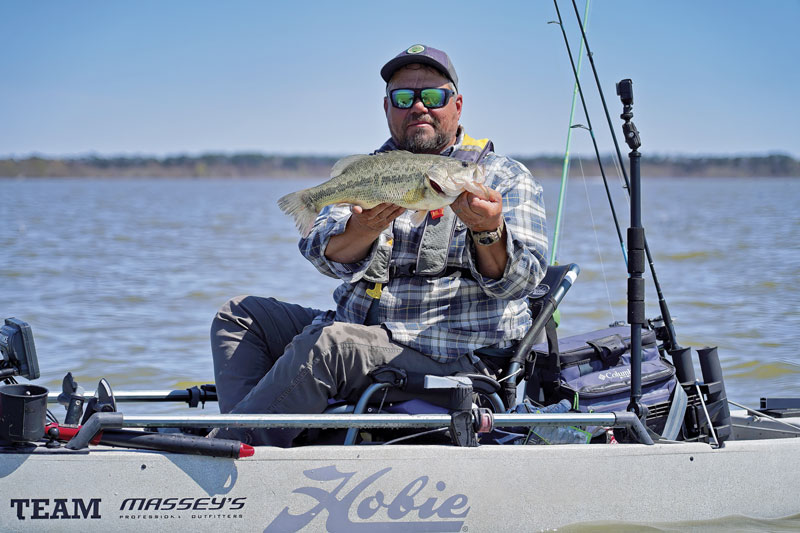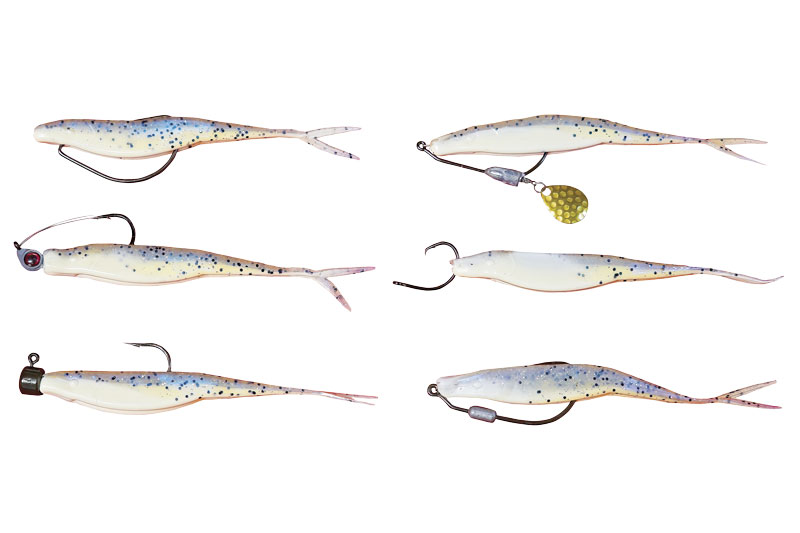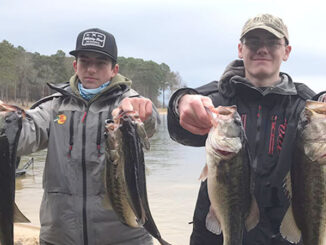
Although it may not always seem like it, September officially brings the end of summer and hopes for cool mornings and mild days.
The doldrums of summer slowly fade and changes in nature progress as days become shorter and vegetation growth begins to slow. With lowering water temperatures, baitfish begin to school and bass become more active. Although deadly year-round, fluke-style baits really excel this time of year. Kayaks are also perfectly suited for this style of fishing.
Fluke-style baits may be the most versatile soft-plastic bass bait there is. It can literally be rigged and fished in countless ways to cover every inch of the water column, impart a variety of actions and mimic nearly any natural prey upon which bass are feeding. Flukes come in a variety of sizes, endless colors, and some are salted or scented. Their basic design is the same with a blunt nose, fatter belly section, with or without a hook slot, and a long, slim tail section, sometimes forked.
For such a simple design, these baits are a favorite among many bass anglers due to their versatility. The most popular method is to rig it weedless with an extra wide gap (EWG) hook in either 4/0 or 5/0 size. The larger gap allows the hook to penetrate further through the thick belly section, ensuring better hook-sets. When fishing near cover, the hooks can be placed to protrude horizontally along the back to avoid picking up grass or snags. It can even be lightly skinned back into the bait for extra hook protection.

Erratic action
When used with no weight, the fluke imparts erratic action unlike any other bait. They sink slowly and any small rod twitch makes the lure jump, twist, and turn with strike-provoking action. At the end of a twitch, they slowly fall-off and glide like a dying bait fish. This fall-off is often when a strike occurs. Although these unweighted lures can be cast on a baitcaster, a spinning outfit is better suited for easy casts. This is also preferred when casting from the sitting position in a kayak as it is easier to cast with less effort.
Unweighted flukes can also be fished on top of heavy cover, skipped under docks or limbs, allowed to sink to the bottom or even slowly trolled. No matter the method, stout hook-sets should be employed in order to drive the hook through the bait and firmly into the bass’s mouth.
As the bait schools move into open water, flukes can be rigged in a variety of other ways. Saltwater anglers regularly use tandem or “double rigs” to catch schooling speckled trout. This method also works great to fish flukes for bass. The easiest way is to use two small swivels. Tie one swivel onto a two-foot section of monofilament with the fluke at the other end. Do the same for a one-foot section. Slide the swivel with the shorter section onto your main line and then tie the longer section to the main line. This set up helps keep the lures from tangling and allows the top lure to slide up the line.
Two bass at a time
This rig looks like two baitfish chasing each other and is deadly when bass are feeding on schooling bait. The flukes can be rigged weightless, on weighted hooks, or small jigheads. If fishing open water where grass or snags are not an issue, rig the hooks to be fully exposed through the baits in order to increase hook-ups. It is not uncommon to catch two bass at a time using this method. If you do get two on the line, this set up lets the fish pull the baits away from each other without getting leverage to pull the hook.
Watch for signs of bass feeding off of points and the mouths of creeks where the bait is penned up. If possible, use the wind to drift towards the action or slowly paddle or pedal into position. Use natural colors or patterns as the bass will likely be feeding on shad. White is often hard to beat. If the surface action subsides, the bite may not be over. Fish the same area, but allow the lures to sink a bit deeper and try all depths before moving to another area.
As noted above, there are endless ways to rig and fish a fluke. Besides weightless, try weighted hooks, jigheads, under-spin hooks/heads or even nose hooked using a Screw Lock and live bait hook. Rigged Texas, Carolina, Tandem, Ned, or Neko style, the fluke can do it all.
However, sometimes, doing nothing is best.
Flukes also excel at “dead sticking” when bass are tight-lipped. Cast and allow the fluke to sink to the bottom, doing nothing for an extended period before beginning the retrieve. Although counterintuitive, this motionless presentation often entices finicky bass into a strike.
From top to bottom or anywhere in between, give a fluke a try on your next fall bass kayak outing and you won’t be disappointed.


